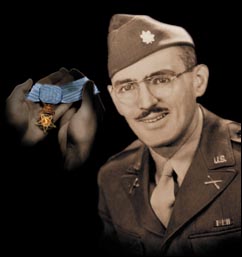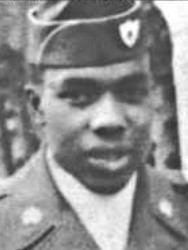This is a list of non-U.S. recipients of U.S. gallantry awards.

John Upshur Dennis Page was a United States Army officer from Saint Paul, Minnesota. Lieutenant Colonel Page received the Medal of Honor for his actions in the Battle of Chosin Reservoir during the Korean War.

Sammy Lee Davis is an American soldier who served in the United States Army during the Vietnam War and was awarded the nation's highest military medal for valor, the Medal of Honor.

Charles Calvin Rogers was a US Army officer and a recipient of the highest military decoration in the United States, the Medal of Honor, for his actions during the Vietnam War.

Maximo Yabes born in Lodi, California, was a United States Army soldier who posthumously received the Medal of Honor — the United States' highest military decoration — for his actions near Phu Hoa Dong in South Vietnam during the Vietnam War. Yabes distinguished himself when he used his body as a shield to protect others in a bunker, moved two wounded men to a safer position where they could be given medical treatment and destroyed an enemy machine gun position before being mortally wounded.

Puerto Ricans have served as members of the United States Armed Forces and have fought in every major conflict in which the United States has been involved from World War I onward. Many Puerto Ricans, including those of Puerto Rican descent, have distinguished themselves during combat as members of the five branches of the U.S. Military, the Army, Marines, Navy, Air Force and the Coast Guard.

Eugene Ashley Jr. was a United States Army Special Forces soldier and a recipient of America's highest military decoration—the Medal of Honor—for his actions in the Vietnam War.

William Maud Bryant was a United States Army Special Forces soldier and a recipient of America's highest military decoration—the Medal of Honor—for his actions in the Vietnam War.

Garfield McConnell Langhorn was a United States Army soldier and a recipient of America's highest military decoration—the Medal of Honor—for his actions in the Vietnam War.

Gordon Douglas Yntema was a United States Army soldier and a recipient of the United States military's highest decoration—the Medal of Honor—for his actions in the Vietnam War.

Charles Quincy Williams was a United States Army major and a recipient of the United States military's highest decoration—the Medal of Honor—for heroism above and beyond the call of duty as an Army Special Forces second lieutenant in the Vietnam War.

George Kenton Sisler was a United States Army intelligence officer and a recipient of the United States military's highest decoration—the Medal of Honor—for his actions in the Vietnam War.

Anund Charles Roark was a United States Army soldier and a recipient of the United States military's highest decoration—the Medal of Honor—for his actions in the Vietnam War.

David Herbert McNerney was a United States Army soldier and a recipient of the United States military's highest decoration—the Medal of Honor—for his actions in the Vietnam War. A native of Massachusetts who moved to Houston, Texas, as a child, McNerney served in the U.S. Navy during the Korean War before enlisting in the Army. He was recognized with the Medal of Honor when, as a first sergeant in Vietnam on March 22, 1967, his company came under attack by a numerically superior North Vietnamese force. They nearly split the company and killed or wounded all of the officers. Although wounded, McNerney took command of the company and organized the unit's defense, exposing himself to hostile fire to mark and clear a helicopter landing site. He refused to be evacuated for an entire day until a new commander came. After serving four tours of duty in Vietnam and 16 years of service, McNerney retired in 1969 and began a career as a customs inspector in Houston.

Finnis Dawson McCleery was a United States Army soldier and a recipient of the United States military's highest decoration—the Medal of Honor—for his actions in the Vietnam War.

John James Kedenburg was a United States Army soldier and a recipient of the United States military's highest decoration—the Medal of Honor—for his actions in the Vietnam War.

Delbert Owen Jennings was a United States Army soldier and a recipient of the United States military's highest decoration—the Medal of Honor—for his actions in the Vietnam War.

Robert John Hibbs was a United States Army officer who graduated from the University of Northern Iowa and was a recipient of the United States military's highest decoration—the Medal of Honor—for his actions in the Vietnam War.

Gary Michael Rose is a retired United States Army officer and a Vietnam War veteran. For his actions during the war, Rose was recommended for the Medal of Honor, but this was downgraded to the Distinguished Service Cross due to the classified nature of the mission in Laos. He was finally presented the Medal of Honor on 23 October 2017.













